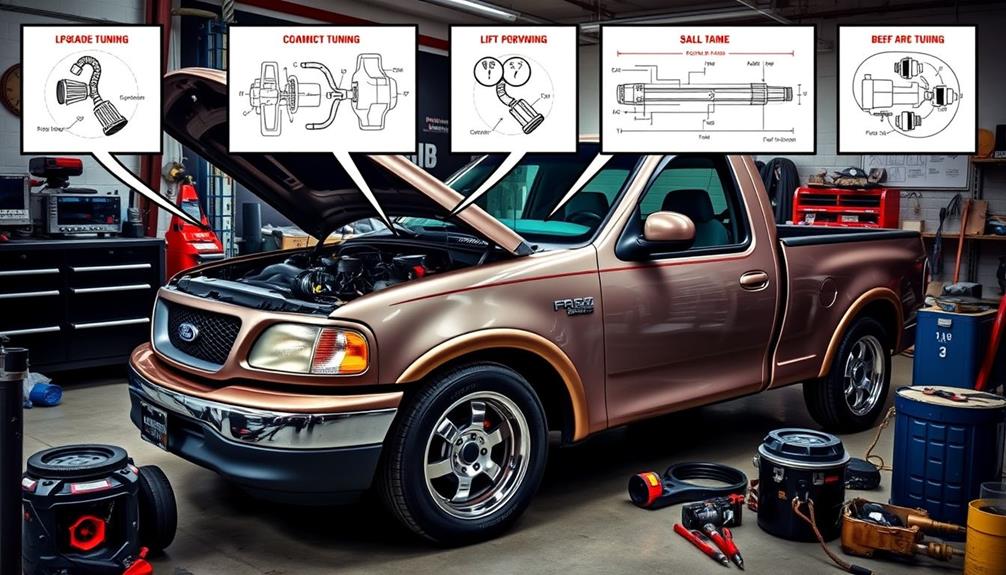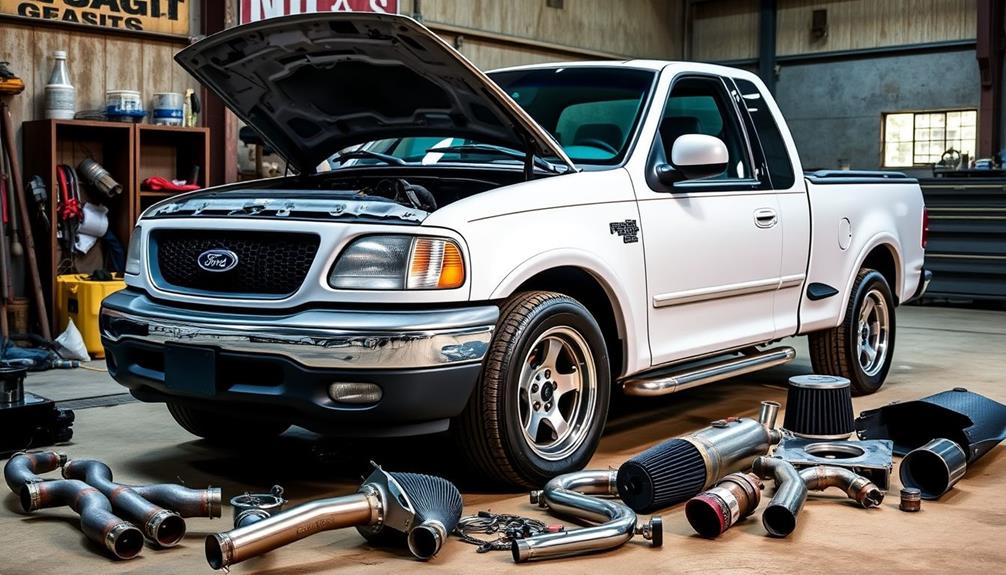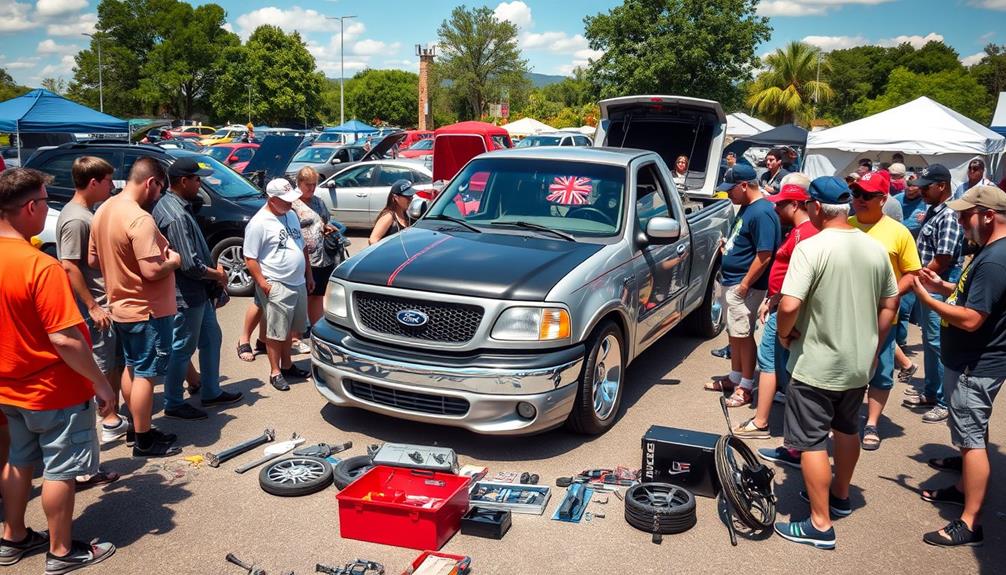Tuning your 2002 Ford F-150 is an excellent way to enhance power and performance. By installing a performance chip, like the Diablo tuner, you can safely boost horsepower and fuel efficiency. For a more significant impact, consider modifications like a cold air intake and a performance exhaust system. These upgrades improve airflow and exhaust flow, leading to a more responsive engine. Just remember to check local emissions regulations before installing any mods. With the right approach, you can transform your reliable pickup into a powerhouse. There's much more to discover about optimizing your F-150's performance.
Key Takeaways
- Performance chips, like the Diablo tuner, enhance horsepower and fuel efficiency by safely modifying engine parameters without damaging the vehicle.
- Common upgrades such as cold air intakes and performance exhaust systems improve airflow and exhaust flow for better engine performance.
- Custom tuning is essential for extensively modified trucks to maximize power and drivability while addressing performance limitations of stock tuning.
- Regular vehicle maintenance, including changing filters and monitoring fluid levels, is crucial for optimal engine efficiency and performance enhancement.
- Smooth driving habits and proper tire maintenance significantly contribute to improved fuel economy in the F-150.
Understanding Performance Chips
When it comes to boosting your Ford F-150's performance, many enthusiasts turn to performance chips. These devices, like the Diablo tuner, typically priced around $300, can greatly enhance both horsepower and fuel efficiency.
Unlike resistors that may harm your engine, performance tuners are engineered specifically to modify engine parameters safely, ensuring you get the most out of your truck without risking damage.
What's great about performance chips is their ability to offer customizable settings. You can adjust your F-150's performance based on factors like tire size and transmission configurations, tailoring it to your specific driving needs.
However, it's essential to recognize that the effectiveness of these chips can vary depending on driving conditions and load, so understanding these variables is vital for maximizing gains.
If you're considering using higher octane fuel, such as 93 octane, be aware that it might offset some of the fuel economy benefits you gain from tuning with performance chips.
Fuel Economy Factors

Understanding the factors that influence fuel economy is essential for optimizing your Ford F-150's efficiency. Your driving style, for instance, can greatly impact your mileage—smooth and careful driving generally yields better outcomes. To accurately assess your fuel economy, calculate your mileage by dividing the miles driven by the gallons used, as the overhead computer readings can sometimes mislead you.
Here's a quick overview of key fuel economy factors:
| Factor | Influence on Fuel Economy | Tips for Improvement |
|---|---|---|
| Driving Style | High | Drive smoothly and avoid rapid acceleration |
| Fuel Selection | Moderate | Use the recommended octane; 93 octane may not always help |
| Tire Selection | High | Choose appropriately sized tires and guarantee proper inflation |
| Vehicle Maintenance | High | Keep your vehicle well-tuned and avoid excess weight |
Enhancing Maintenance and Tires

Keeping your Ford F-150 well-maintained is essential to achieving peak performance and fuel efficiency. Regular maintenance tasks, like changing air and fuel filters, can make a noticeable difference in your engine's efficiency.
Additionally, understanding the significance of proper fuel types and their impact on engine health can further enhance performance; for example, using high-quality fuel can prevent engine knocking and improve mileage. By ensuring your vehicle is always tuned, you'll enhance fuel economy, especially when driving at moderate speeds.
Choosing the right cold medication can also help maintain overall well-being during seasonal changes that might affect your driving experience.
Tire selection plays a significant role too. It's important to choose the right tires for your F-150; wider tires can negatively impact your mileage. Make sure your tires are always properly inflated, as this helps optimize fuel efficiency.
Additionally, maintaining proper tire alignment reduces drag, which is crucial for improving overall mileage.
Don't forget to conduct routine checks on fluid levels, including engine oil and transmission fluid. Keeping these fluids in check can help you avoid performance loss, making your truck run smoother.
Common Performance Issues

When tuning your 2002 F-150, you might hit some common performance issues that can limit engine power and affect transmission performance.
It's essential to run regular diagnostics to pinpoint any underlying problems.
Understanding how your modifications interact with these factors can help you achieve the performance gains you're aiming for.
Engine Power Limitations
Despite the advancements in automotive technology, the 2002 Ford F-150 can still face engine power limitations that hinder performance. While the new engines and transmissions promise improvements, they mightn't fully deliver due to several inherent vehicle issues.
You might find that performance chips alone won't solve these problems; factors like weight and tuning greatly influence your truck's overall power.
One common bottleneck is the stock intake system, which can restrict airflow and limit your engine's potential. Upgrading to aftermarket options like cold air intakes is vital for achieving maximum horsepower.
However, if you're seeking considerable power gains, you'll likely need to evaluate extensive modifications beyond basic bolt-ons. The conservative factory tuning often restricts your truck's performance potential.
User experiences vary widely when modifying the 2002 F-150, underscoring the importance of regular diagnostics. Understanding your vehicle's unique conditions is essential to address these engine power limitations effectively.
Transmission Performance Challenges
How can you enhance your 2002 Ford F-150's transmission performance? First, it's important to acknowledge that even with engine and transmission upgrades, you might still face transmission performance challenges.
The inherent design limitations and weight factors of the 2002 model can hinder significant power improvements. While performance chips can adjust shift points for better acceleration, they often don't address the fundamental tuning or mechanical issues.
To truly boost your transmission's performance, extensive modifications may be necessary. However, be cautious; aggressive tuning can increase strain on drivetrain components.
Finding the right balance between enhancements and reliability is key. Regular diagnostics are essential to identify any underlying issues, as your vehicle's history and existing modifications can greatly influence performance outcomes.
Diagnostic Recommendations for Issues
To effectively diagnose performance issues in your 2002 Ford F-150, it's vital to take a systematic approach that combines regular check-ups with keen observation of your vehicle's behavior.
Even with updated engines and transmissions, you might still face power problems. Here are some diagnostic recommendations to help you pinpoint issues:
- Check for Vacuum Leaks: These can notably impact your engine's performance. Inspect hoses and connections for any signs of wear or damage.
- Monitor Fluid Levels: Regular fluid changes are important. Confirm that your oil, transmission fluid, and coolant are at ideal levels to prevent performance loss.
- Engage with Community Forums: Sharing experiences with fellow F-150 owners can provide valuable troubleshooting techniques. Learn from others who've faced similar performance challenges.
Evaluating the Used F-150 Market

When you're exploring the used F-150 market, you'll notice significant pricing trends and variability that can impact your budget.
Popular modifications might enhance performance but can also affect resale value, so it's worth considering their long-term implications.
Plus, gathering reliability and maintenance insights from previous owners can guide you toward a more informed purchase.
Pricing Trends and Variability
The used F-150 market showcases a broad spectrum of pricing trends and variability, making it an appealing option for buyers with different budgets. CarGurus lists nearly 145,000 F-150s nationwide, with prices starting as low as $995. This diverse range allows you to pick a model that fits both your financial situation and performance needs.
When you're diving into the used F-150 market, here are three key factors to take into account regarding pricing trends and variability:
- Model and Trim: Different trims offer varying features and performance levels, which can greatly affect pricing.
- Condition and Mileage: The overall condition and mileage of the truck play an essential role in determining its price.
- Market Demand: Regional demand can fluctuate, impacting prices. Some areas may have higher demand for specific models, driving up costs.
Engaging in thorough research and reading user reviews can provide valuable insights into reliability and performance. This information is important for making a satisfactory investment in a used F-150, ensuring you get the best deal possible.
Popular Modifications Impact Value
Many F-150 owners turn to popular modifications to enhance performance and aesthetic appeal, but these changes can greatly impact a truck's resale value. In the vast used F-150 market, which boasts over 144,989 listings, buyers often seek vehicles that fit their budget and preferences.
If you've modified your F-150, it's essential to understand how these popular modifications impact value. Evaluating Bitcoin IRA Suitability is similar in that determining personal goals and risk is important before making changes.
While performance upgrades like chips or engine enhancements can attract some buyers, others may prefer stock vehicles for reliability. The type and extent of modifications you make can markedly influence market demand for your specific model.
If you've made well-received upgrades, you might find your truck holds its value better. However, poorly executed changes can deter potential buyers, making it important to research the history of modifications and their effects on reliability.
User experiences and reviews also play a key role in how modified F-150s are perceived in the market. Ultimately, striking the right balance between personal preference and resale value is crucial when considering modifications for your F-150.
Reliability and Maintenance Insights
Understanding the reliability and maintenance of used F-150s is essential for anyone evaluating a purchase in this competitive market. With nearly 145,000 F-150s listed nationwide, you've got plenty of options, but choosing wisely is key.
Here are three important factors to reflect on:
- Maintenance History: Always check the maintenance records. A well-documented history can indicate reliability and how well the previous owner took care of the truck.
- User Reviews: Explore user experiences and reviews to gauge the reliability of different 2002 F-150 models. These insights can reveal common issues and performance over time, aiding your decision-making.
- Community Engagement: Engage with forums and online communities. They can provide valuable information on reliability concerns specific to the 2002 model, helping you avoid potential pitfalls.
Engine Modifications Explained

When it comes to boosting your 2002 Ford F-150's performance, engine modifications are key. Understanding the fundamentals of engine modifications explained can help you make informed choices.
Common upgrades include installing a cold air intake (CAI) and aftermarket exhaust systems, which improve airflow and enhance overall performance.
For better engine response, consider ported throttle bodies; they offer more precise airflow management. If you're looking for a significant horsepower increase, forced induction options like superchargers can be a game-changer, though they come with a hefty price tag—around $5,000 for reliable setups.
Keep in mind that basic modifications typically yield minimal power gains. To achieve substantial improvements, you may need to make extensive changes to your engine's internal components.
For naturally aspirated setups, expect to max out around 260 rear-wheel horsepower (rwhp), highlighting the importance of knowing your stock component limitations.
A successful combination of intake modifications, exhaust upgrades, and proper tuning is essential for peak performance enhancements in your Ford F-150. By focusing on these key areas, you can elevate your truck's capabilities and enjoy a more exhilarating driving experience.
Tuning Options Overview

When tuning your 2002 Ford F-150, you'll find various options available, including economy, towing, and performance tunes.
Each type offers unique benefits, so you can tailor your truck to meet your specific driving needs.
Types of Tuning Options
Tuning options for the 2002 Ford F-150 offer a range of enhancements to improve both performance and efficiency. You can choose from several types of tuning options, each targeting different aspects of your vehicle's capabilities.
Here are three main categories to take into account:
- Performance Tunes: These tunes enhance horsepower and torque, making your truck feel more powerful and responsive on the road.
- Economy Tunes: Designed to improve fuel efficiency during daily driving, these options help you save at the pump without sacrificing too much performance.
- Custom Tunes: If your F-150 has extensive modifications, custom tunes allow for tailored adjustments that maximize the power potential and drivability of your truck.
Additionally, advanced tuning can modify critical parameters like fuel delivery and ignition timing, but you'll typically need prior engine modifications for peak gains.
Basic tuning options often focus on changing transmission shift points to improve acceleration, enhancing your overall driving experience.
Tools like the MyCalibrator Touch tuner offer features such as enhanced throttle response and modified transmission shifting, making them a great choice for anyone looking to expand their tuning options.
Performance Chip Benefits
Releasing the full potential of your 2002 Ford F-150 is easily achieved with performance chips, which deliver impressive benefits for both power and drivability. By installing a performance chip, you'll notice a significant boost in engine power output and torque. This enhancement translates into better throttle response and quicker acceleration, making your driving experience much more enjoyable.
Additionally, optimizing your vehicle's performance can lead to improved fuel efficiency, allowing you to save on costs in the long run, similar to creating a personal budget for better financial management. The installation process is straightforward, typically taking only 30-60 minutes, and over 98% of users successfully complete it themselves thanks to clear instructions.
Many performance chips also allow you to adjust transmission settings, including shift points, further improving your truck's overall performance.
If you're using higher octane fuel, like 93 octane, you can maximize these performance chip benefits, potentially achieving peak power increases of over 89 WHP and 92 WTQ. However, it's crucial to keep in mind that these chips might affect your vehicle's emissions. Always check your local emissions regulations before installation to verify compliance.
Performance Limitations to Consider

Performance limitations in the 2002 Ford F-150 stem largely from the conservative factory settings that restrict potential power adjustments. You might find that while basic modifications can enhance performance, they often don't yield substantial gains due to these limitations.
Here are three key factors to keep in mind:
- Stock Tuning: The factory settings are designed more for reliability than for performance, making it tough to achieve significant power boosts without extensive modifications.
- Exhaust Back Pressure: The exhaust system plays a vital role in your truck's performance. Choosing the right aftermarket exhaust can help alleviate back pressure, but it's important to select wisely for best results.
- Tuning Parameters: Older models like the 2002 F-150 have limited tuning options. To make meaningful adjustments, you'll often need a combination of intake, exhaust, and custom tuning rather than relying solely on performance chips.
Understanding these performance limitations will help you set realistic goals for your F-150 tuning journey. You'll be better equipped to choose modifications that truly enhance your truck's capabilities.
Recommended Modifications

When looking to enhance your 2002 Ford F-150, you'll often find that certain modifications consistently deliver impressive results. Among the most recommended modifications is installing a cold air intake (CAI). This upgrade improves airflow, leading to better engine performance and responsiveness.
Additionally, focusing on content relevance and authority when selecting modifications can help guarantee you're making informed choices. Pair this with a performance exhaust system to enhance exhaust flow and sound, giving your truck a more aggressive tone.
Next, consider upgrading to a performance chip or tuner, like the Diablo tuner. This modification can yield noticeable gains in horsepower and torque while allowing you to adjust settings for tire size and transmission performance.
If you're aiming for serious power, forced induction options such as superchargers can provide significant improvements, albeit typically requiring around $5,000 for reliable installations.
Lastly, don't overlook the importance of regular maintenance. Fresh spark plugs and filters are essential for confirming that your modifications deliver peak performance and fuel efficiency.
Community recommendations often emphasize combining intake, exhaust, and tuning modifications to achieve the best overall enhancements for your 2002 F-150. These recommended modifications will help you release your truck's full potential while keeping it reliable.
Engaging With the Community

Engaging with the community around your 2002 Ford F-150 can considerably enhance your tuning journey. By connecting with fellow enthusiasts, you'll gain valuable insights that can guide your performance modifications.
Here's how to get started:
- Join forums: Many online platforms allow you to post your tuning results and seek advice on specific upgrades. This collaborative environment is perfect for novice tuners.
- Share and learn: Community discussions often include recommendations on performance chips and modifications. You'll find users keen to share their experiences with power gains and potential issues.
- Stay updated: Participating in these forums helps you stay informed about the latest tuning techniques, product releases, and maintenance tips tailored specifically for your F-150.
As you engage, you'll also make links to various merchants who offer the best parts for your build. This not only streamlines your shopping experience but also guarantees you're getting reliable products that fit your needs.
Frequently Asked Questions
How Can I Get More Power Out of My F-150?
To get more power out of your F-150, consider installing a performance chip, upgrading to a cold air intake, and maintaining regular upkeep. Custom tuning can optimize performance, enhancing your truck's overall capabilities and efficiency.
How Does the Ford F-150 Power Boost Work?
Imagine releasing a lion's roar with the Ford F-150 Power Boost. It blends a twin-turbo V6 with an electric motor, delivering impressive power while boosting fuel efficiency and offering regenerative braking for smarter energy use.
What Does a Tuner Do for an F-150?
A tuner optimizes your F-150's engine performance by adjusting fuel delivery, ignition timing, and transmission settings. You'll experience increased horsepower, improved throttle response, and potentially better fuel efficiency, enhancing your overall driving experience.
What Is the Best F-150 Motor Option?
If you're looking for power and reliability, the 5.4L Triton V8 is your best bet. It delivers around 300 horsepower and 365 lb-ft of torque, making it ideal for towing and everyday driving.
Conclusion
As you rev up your 2002 Ford F-150, imagine the roar of the engine echoing through the open road, beckoning adventure. By exploring tuning options and recommended modifications, you're not just enhancing power; you're transforming your reliable pickup into a true powerhouse. Embrace the thrill of improved performance and join a community of enthusiasts who share your passion. With each upgrade, your F-150 becomes more than a truck; it becomes an extension of your spirit, ready for whatever lies ahead. Whether you’re aiming for increased horsepower, better fuel efficiency, or simply a more responsive throttle, there are countless *Ford F-150 tuning tips* to guide you through the customization process. From ECU reflashes to aftermarket intakes and exhaust systems, the possibilities are endless. Each tweak brings you closer to crafting the ultimate driving experience, uniquely tailored to your journey.










